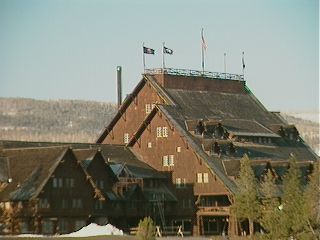

Friday, May 2, 1997, is the opening day of Yellowstone National Park's most famous building, the Old Faithful Inn. Overlooking Old Faithful Geyser and the Upper Geyser Basin, the Inn has been the most celebrated structure in Yellowstone since it first opened in June of 1904. The Inn is also a standing tribute to a great and unsung American architect, Robert Chambers Reamer.
Robert Reamer was born in 1873, just a year after Yellowstone was established as the nation's first national park. Reamer was a relatively unknown architect when Harry Child, head of the Yellowstone Park Company, hired him in 1902 to design and build a hotel for the Upper Geyser Basin. There had been a series of tent camps and cheaply constructed, shoddy hotels at this site during the previous two decades, and Child wanted to construct a first-class hotel for the wealthy customers who constituted the bulk of Yellowstone's visitors at the turn of the century.
Fine hotels already stood at Mammoth Hot Springs, Lower Geyser Basin, Yellowstone Lake, and Canyon. These facilities stood out sharply from their surroundings and reflected the way visitors to Yellowstone toured the park in those days. Guests would spend a leisurely day marveling at the wonders of the park and then return to a hotel that looked and felt like one they might find in Chicago, New York, or Newport. These hotels represented a place of refuge for the night against the frightening wilderness outside.
 Robert Reamer brought a different vision with him to Yellowstone.
He believed it was possible to create a structure that would appear
to have grown out of its surroundings, a structure that inside and out
would seem to be an extension of the wilderness. At the same time,
he believed that a hotel such as this could provide all the modern
conveniences that any first-class hotel around the world offered. He
believed that hotel guests would feel completely secure while at the
same time feel a part of the wilderness outside.
Robert Reamer brought a different vision with him to Yellowstone.
He believed it was possible to create a structure that would appear
to have grown out of its surroundings, a structure that inside and out
would seem to be an extension of the wilderness. At the same time,
he believed that a hotel such as this could provide all the modern
conveniences that any first-class hotel around the world offered. He
believed that hotel guests would feel completely secure while at the
same time feel a part of the wilderness outside.
The Inn was constructed from materials found in the area. Its rhyolite lava foundation stones were quarried just a few miles from the site, and the lodgepole pine forests that cover Yellowstone became its walls, ceilings, and framework. The lobby is cavernous and opened to the roof, with all the supporting beams and braces of lodgepole pine exposed to view. The massive fireplace in one corner of the lobby has an 85-foot high chimney made from the same rhyolite stone as the foundation. To stand in this great, balconied lobby as the sun filters through the asymmetrical windows gives one the feeling of standing in the forest. But with hot and cold running water, flush toilets, baths, steam heat, and electric lights, the Inn was--and is--a first-class hotel.
Robert Reamer caused a revolution in architecture in national parks that has continued to this day. His style of architecture, where the building is designed to fit into the landscape, is called "rustic architecture." Reamer designed many other Yellowstone structures for the Yellowstone Park Company, and he went on to become a well-respected architect in Seattle, where the Fifth Avenue Theater, Edmond Meany Hotel, and other structures that he designed are still standing and cherished. Mr. Reamer died in 1938.
Reamer's vision can best be summarized in his own words, spoken as he reflected on the construction of the Canyon Hotel, which stood overlooking the Grand Canyon of the Yellowstone River from 1911 until 1960:
"I built it in keeping with the place where it stands. Nobody could improve upon that. To be at discord with the landscape would be almost a crime. To try to improve upon it would be an impertinence."
![]() Comments
and Questions are Welcome.
Comments
and Questions are Welcome.
This site is hosted by Geocities. Get your own Free Homepage.